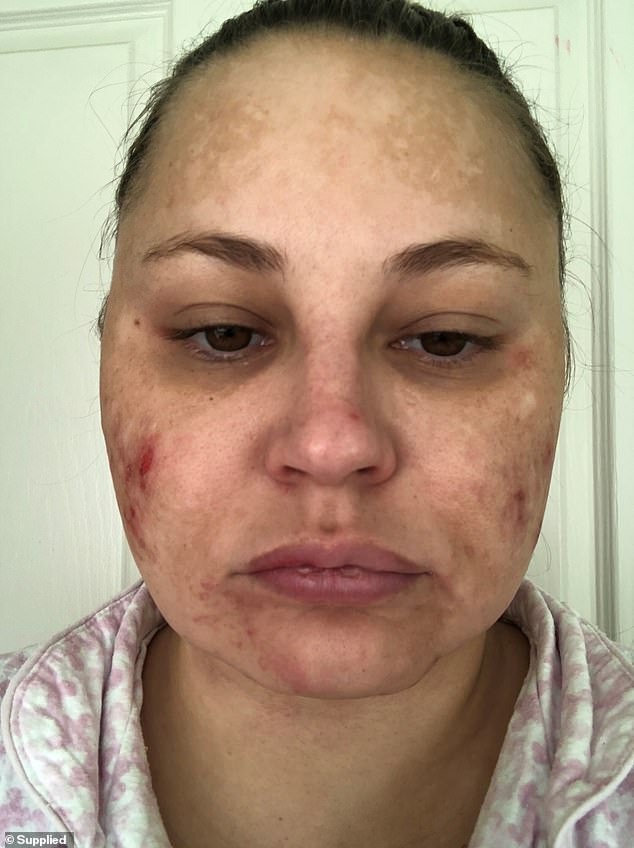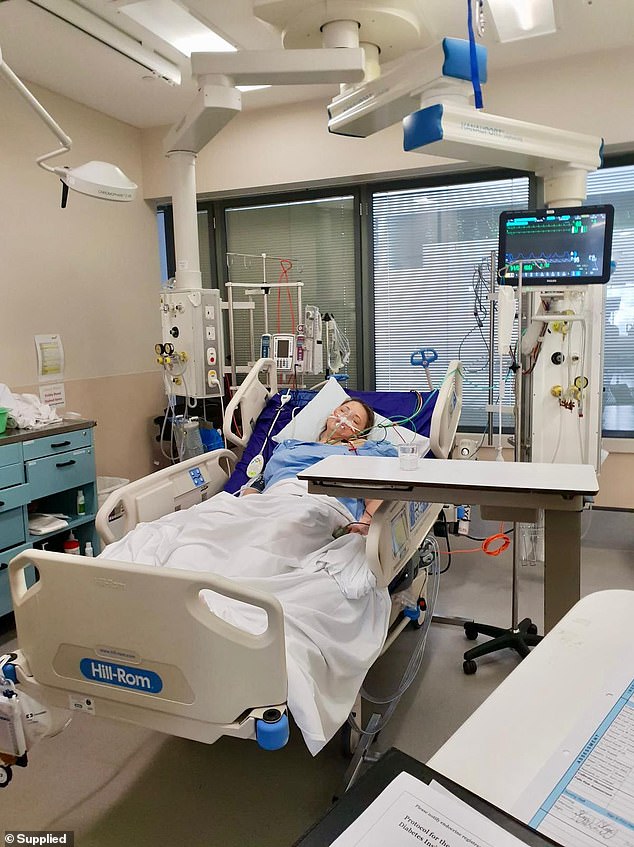Cushing’s disease: Ania was fit, healthy and just 31 when her face started to swell and break out in painful wounds that wouldn’t heal
Ania Stepien dreamed of getting married and one day becoming a mother, but her 30th birthday was taken away from her after she was diagnosed with a rare disease.
She was fit, healthy and active, but at the age of 31 she began experiencing strange symptoms that developed ‘overnight’.
She suffered from open sores on her face that would not heal, rapid and excessive weight gain, changes in her face, and extreme fatigue.
Between 2014 and 2019, doctors consistently ignored the symptoms, leaving the young Sydney woman increasingly frustrated and feeling like she was ‘going to die’.
Eventually, four years later, Ania was diagnosed with Cushing’s disease after an MRI scan revealed a 6mm tumor in the pituitary gland in her brain.
Cushing’s disease is a condition that occurs when the body produces too much cortisol over a long period of time. Although the disease was caused by her tumor, the cause of the growth is unknown.
“This disease has cost me my health, my job, my relationship and even my mind,” Ania, now 41, told FEMAIL.
Even after the tumor was surgically removed, she was still hit hard: she became paralyzed by adrenal insufficiency, because her body was not producing enough cortisol.
Ania Stepien (pictured) was diagnosed with Cushing’s disease at age 35 after years of searching for answers

The symptoms were consistently ignored by doctors between 2014 and 2019, leaving the young Sydney woman increasingly frustrated and feeling like she was ‘going to die’
“Cushing’s is a one in a million disease and there is no test for it,” claimed Ania, who is pursuing a master’s degree in journalism and is focusing on research into cortisol and the “huge misconceptions” circulating online.
“I could barely walk, I couldn’t breathe, you feel like you’re losing your mind. It’s like you know you’re dying, but everyone thinks you’re crazy. So I’ve had second, third, fourth opinions from different doctors,” she said.
Ania gained 30 kilos in three months, going from a size 38 to a size 46. Her face swelled so much that she was unrecognizable.
Over the next four years, Ania’s health continued to deteriorate. The disease made it increasingly difficult for her to think clearly and to perform simple daily tasks, such as making coffee.

She suffered from open sores on her face that would not heal, excessive weight gain overnight, facial changes and extreme fatigue. Four years later an MRI discovered a 6mm tumor growing in the pituitary gland of her brain (before and after pictured)
Ania went to the emergency room of her local hospital and demanded that a doctor listen to her and look at her debilitating symptoms. It was there that doctors finally began to take her seriously.
She met physician and pituitary tumor researcher, endocrinologist Associate Professor Ann McCormack, who made the diagnosis on the spot.
“She looked at me and said, ‘I think you have Cushing’s disease.’ So I had a brain scan and I taught myself how to read the images before they found the tumor,” Ania recalled.
“When I saw the tumor, I thought, ‘Thank God,’ because I finally had answers. But it was just one piece of the puzzle.”
Shortly after her diagnosis, Ania underwent surgery to remove the small tumor in her brain that was causing her continued suffering. Before going in, she also decided to freeze her eggs.

Ania, now 41, underwent surgery to remove the tumor, which was successful, but she was left with adrenal insufficiency because the body was no longer producing enough cortisol on its own
“I was glad I had the surgery because I thought this nightmare would be over,” she said.
Although the treatment was successful, she continued to suffer from adrenal insufficiency because her body no longer produced enough cortisol.
Although this is a common problem and usually lasts about nine months, Ania suffered from it for a whopping four and a half years.
This led to severe symptoms including paralysis, extreme nausea, vomiting and an ‘inability’ to function on a daily basis.
“With Cushing’s I could still move, but with adrenal insufficiency I was in bed all day. My brain wasn’t functioning properly, I couldn’t drive and I felt like I had lost everything,” she said.
“I’m now terrified of having another operation.”

“With Cushing’s I could still move, but with the adrenal insufficiency I was in bed all day, my brain wasn’t functioning properly, I couldn’t drive, I felt like I had lost everything,” she said
The symptoms persisted until one day her pituitary gland “woke up” and she jumped out of bed full of energy.
‘I walked everywhere and was healthy for nine months. Within three months I even crossed the whole of Spain,’ says Ania.
Her cortisol levels fluctuate, but she is still able to work full time and meet up with friends, but she no longer exercises.
“I’m currently having a relapse, so I’ve gained another 30 pounds in a month, but it’s not ‘bad’ yet,” she said.
Research has shown that 50 percent of recurrences occur in the first 50 months after the initial surgery. There are several treatment options, including a second surgery, pituitary radiation, and targeted medical therapy to control hypercortisolism.
Looking back, Ania is devastated that she was unable to start a family and meet the man of her dreams because she had been ill for years.
“I had to go back home to my parents. I’ve always wanted a child, but I’m 41, what am I supposed to do with it? There are also questions about how sick I can get and whether it’s fair to raise a child like this,” she added.
‘When you’re sick, you kind of lose everything and nothing really matters because you’re so sick that you just want to go back to your normal life. My biggest dream was to go back to the time when I wasn’t sick.’
To this day, doctors are unsure whether the disease will return in full.
Now Ania is fighting for more funding for the only research group in Australia focusing on pituitary tumors.
“You know your body best, so always get a second, third, or fourth opinion. Educate yourself, but use trusted sources — and don’t rely on TikTok or influencers, because there’s not a lot of miscommunication about Cushing’s and cortisol,” she said.
